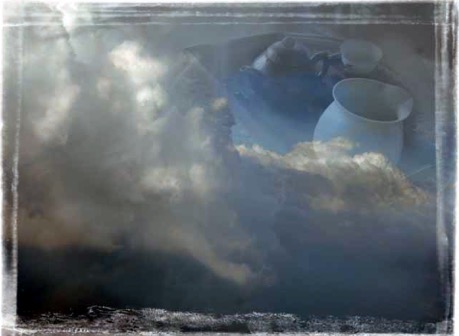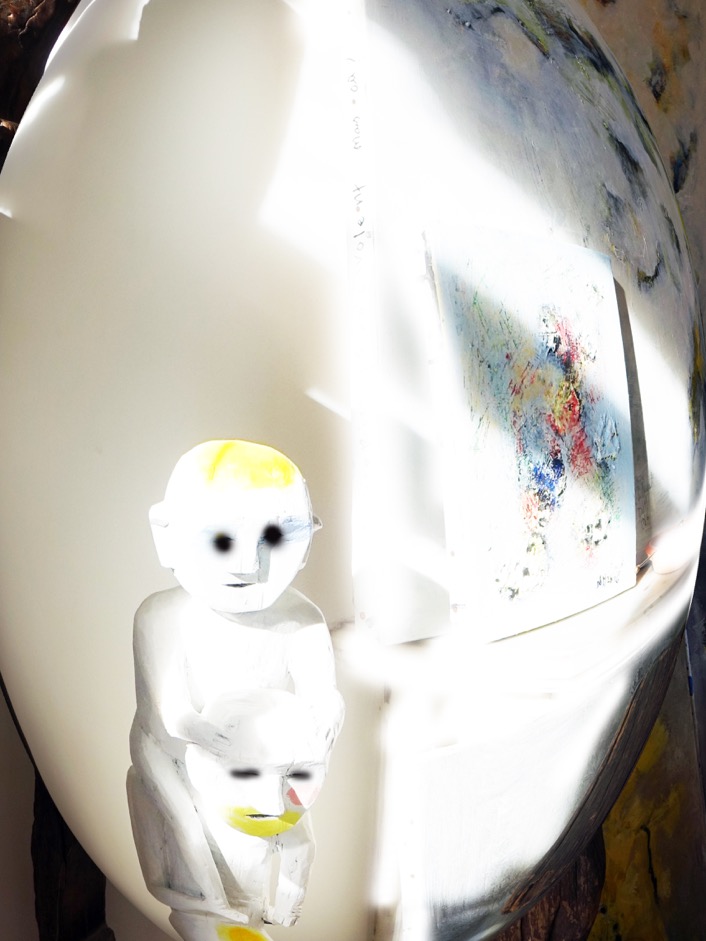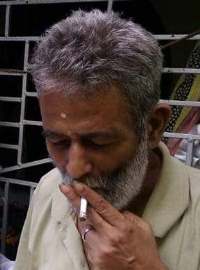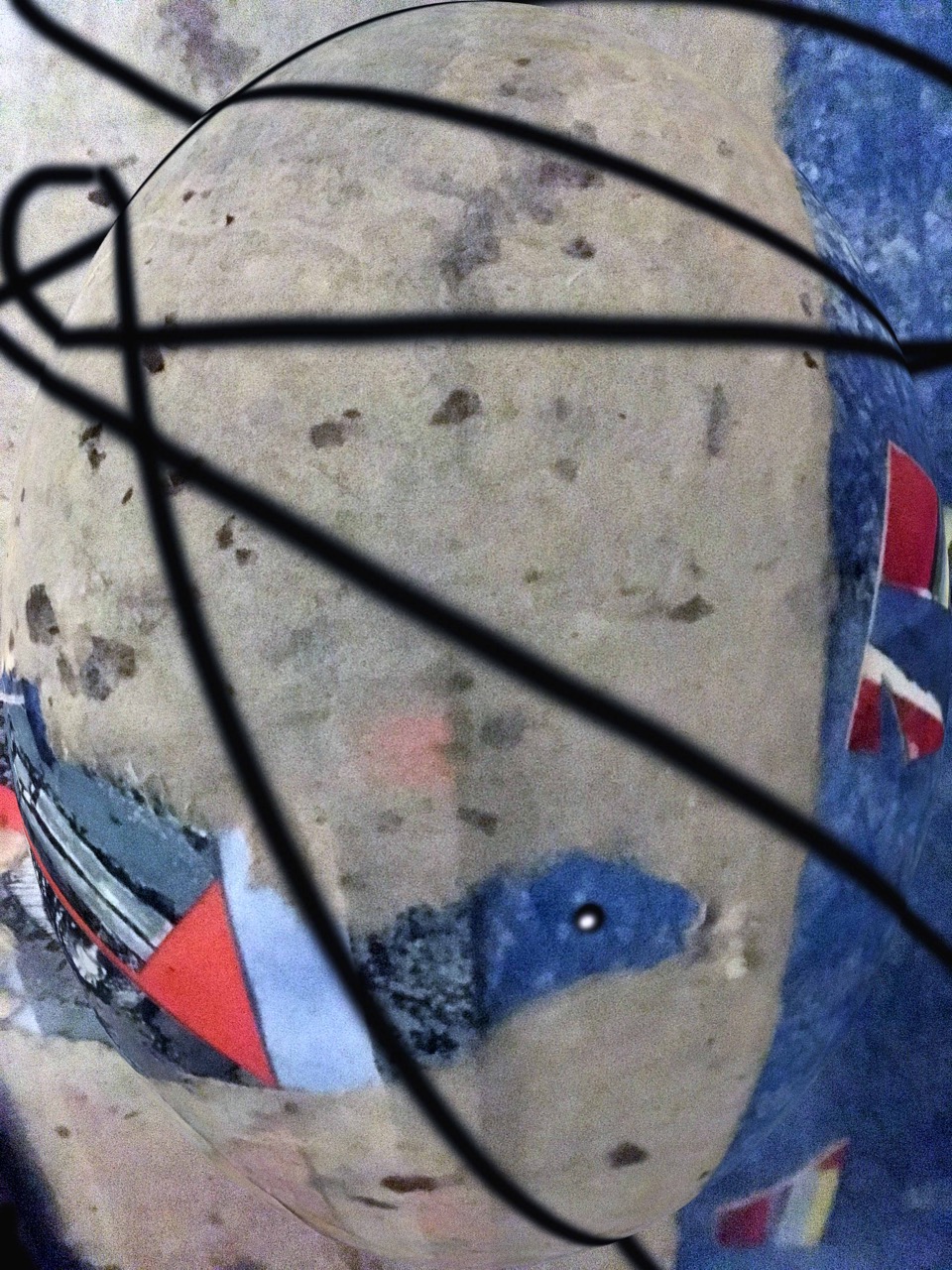Silence (42) - Mai Văn Phấn. Explication par Dr. Ramesh Chandra Mukhopadhyaya. Traduction française Dominique de Miscault
Explication par Dr. Ramesh Chandra Mukhopadhyaya
Traduction française Dominique de Miscault

Tác Phẩm của Nghệ sỹ Dominique de Miscault
Silence
42
Je suis assis sous un manteau de Lumière
tout en bas
Il marche
son manteau me frôle
de la tête
aux pieds
Je suis lumière au réveil
abandonnant
l’espace aux rêves
Des rêves
sans nuit.
Explication
Si Mai Văn Phấn est considéré comme un poète représentatif du Vietnam, un Indien comme moi estime que nous sommes de la même famille. Ses poèmes sondent la profondeur de l'esprit et nous indiquent les chemins de la paix, de la libération par la culture et le contrôle des sens extravertis, lus comme des aphorismes de la philosophie du yoga indien. Quoi de plus normal chez les grands poètes. Peu importe qu'ils viennent du Vietnam ou de France, un Indien dirait simplement qu'il est Indien et un Bulgare qu'il est Bulgare. Il n'est pas un abominable ennemi. Isha Upanishad , l'un des écrits hindoues, s'ouvre avec le verset :
Isaavaasyam idam sarvam
Yat kincha jagatyaam jagat
Le verset introduit un Dieu qui couvre tout ce qui existe dans ce monde. Tout dans ce monde agité et éphémère est demeure de Dieu. Le poète vietnamien Mai Văn Phấn prouve que l'Isha Upanishad n'a pas besoin de commentaire. La vérification est souvent un critère de la vérité. Ce que Isha Upanishad dit est vérifié par l'expérience du poète Mai Văn Phấn :
Je suis assis sous un manteau de Lumière
tout en bas
Qu'est-ce qu'un manteau ? un vêtement sans manche qui protège le corps. Selon les divinités des Upanisades, Dieu comme le manteau protège ce monde. Dieu est léger. L'expérience de Mai Văn Phấn témoigne de la vérité des Upanisads. Il est assis sous un manteau de lumière, tout au fond. La perception de Mai Văn Phấn indique que le manteau de lumière est Dieu. Nous ne voyons pas Dieu. Mais nous pouvons désirer son manteau de lumière. Ce n'est pas tout. Le poète peut ressentir et toucher le manteau de bas en haut. Ainsi, toute l'existence est enveloppée dans un manteau de lumière qui est Dieu. Ici, le poète intensifie le pouvoir du toucher chez les lecteurs. Et puisque le manteau de Dieu, de temps en temps frôle le poète du haut jusqu’en bas, bien que le poète ne puisse pas voir Dieu directement, il peut néanmoins ressentir et toucher les chasubles de Dieu. Notre culture donne du poids à la perception par l'œil. Mais le toucher est une sensation aussi réelle que la vue. Lorsque les vêtements de Dieu sont lumière, ils frôlent le poète et le poète sent que le panenthéisme est Vérité et non le panthéisme. Parce que si Dieu et la création sont un, le mouvement de Dieu séparé de celui de l'univers ne pourrait être ressenti. Le poète a rendu le touché aux lecteurs enthousiastes. Dieu est vivant. Nous nous languissons de lui. Les spectacles de la vue et les sons ne peuvent pas nous transporter dans cette dimension mystique. Quand le poète se réveille, il est ceint de lumière, mais quand il dort, sa conscience l’abandonne. Il se remet aux mystères de l'inconscient, plongé dans ses rêves. Le poète avertit les lecteurs confiants et leurs dit :
Il y a des rêves
sans nuit.
La lumière est au centre de l'obscurité et l'obscurité est au centre de l'obscurité. S'il n'y avait pas d'obscurité, il n'y aurait pas de lumière. S'il n'y avait pas de lumière, il n'y aurait pas d'obscurité. Mais, la lumière n'est pas la vérité, et l'obscurité n’est pas la vérité non plus, ni la lumière n'est la vérité ni l'obscurité vérité, et non la lumière n'est pas la vérité, et les ténèbres non plus, c'est la Vérité. C'est le post-modernisme et Derrida. Mais notre poète se réfère à une lumière qui n'a jamais été sur la mer ou la terre. Le poète éprouve une lumière qui dépasse la lumière et l'obscurité du monde contingent. Cela pourrait nous rappeler le yoga des rêves des Tibétains. La lumière que le poète éprouve est la lumière de la pure conscience. C'est la nature fondamentale lumineuse qui est réalité absolue. La lumière de la conscience dans le rêve n'est pas polluée par les traces karmiques. Comme il n'y a pas de traits karmiques, le rêve ne contient aucun contenu. Par conséquent, le rêve n'existe pas. Le rêveur n'existe pas non plus. La lumière seule existe. Une lumière qui n'a jamais existé sur la mer ou la terre.
Isha Upanishad (Upaniṣad du Seigneur) est l'une des plus courtes des upanisad majeures ou principales, composée de 18 versets au total. Ce texte court associé au Shukla Yajur Veda (blanc) qui aborde certains aspects relatifs à la philosophie, la religion, le rituel et la métaphysique.
Le panenthéisme est un système de croyance qui postule que le divin existe et interpénètre toutes les parties de la nature, mais que, dans le même temps, il se déploie au-delà d'elle. On distingue le panenthéisme du panthéisme qui tient que le divin est tout entier dans l'univers, sans lui être ni extérieur, ni supérieur. Dans le panenthéisme, l'univers et le divin ne sont pas ontologiquement équivalents. Dieu n'est pas considéré comme le créateur ou le démiurge, mais plutôt comme la force éternelle qui anime l'univers, celui-ci n'étant rien d'autre que la partie manifeste de Dieu. L'univers existe à l'intérieur même de Dieu qui, à son tour, est diffusé en chaque partie du cosmos ou se trouve en lui. Tandis que le panthéisme affirme que « Tout est Dieu » et que Dieu possède la même portée ou les mêmes limites spatiales ou séquentielles que le cosmos, le panenthéisme va plus loin en déclarant que Dieu est plus grand que l'univers et que ce dernier est contenu en Lui, comme dans le concept de Tsimtsoum. Dieu est à la fois l'influence suprême qui agit sur l'univers, tout en étant le résultat de celui-ci. Une bonne partie de la pensée hindoue est une expression de panenthéisme et de panthéisme.
Silence (42) by Mai Văn Phấn
Explicated by Dr. Ramesh Chandra Mukhopadhyaya
Translated into French by Dominique de Miscault
Translated into Vietnamese by Takya Đỗ

Tác phẩm của Nhà thơ - Họa sỹ Dominique de Miscault chọn cho bài thứ 42
Silence
42
I sit under the cloak of Light
At the very bottom
When He walks
His cloak touches me
Sometimes from above
Sometimes from below
I am dyed with light when waking up
But when sleeping
I leave it up to dreams
There are dreams
Where you cannot find darkness.
(Translated from Vietnamese by Nhat-Lang Le & Susan Blanshard)
Explication
If Mai Văn Phấn is deemed as a representative poet of Vietnam, an Indian like the present author feels that the poet is a kin of an Indian. His poems that probe into the unplumbed depth of the mind and show us the way to peace and liberation through the cultivation of the mind and through the control of the extrovert senses read like the aphorisms of Indian yoga philosophy. This is what happens with great poets. No matter whether they are from Vietnam or France, an Indian would claim that he is an Indian and a reader from Bulgaria might claim that he is a kin of a Bulgarian. This is not a dull encomium. The Isopanisad one of the Hindu scriptures opens with the verse.
Isaavaasyam idam sarvam
Yat kincha jagatyaam jagat
The verse points out that God covers every thing that exists in this transitory world. Everything in this restless and transitory world is the abode of God. The poet Mai Văn Phấn from Vietnam proves that the Upanisad did not make any passing comment. Verifiability is often the criteria of truth. What Isopanisad says could be verified by the experience of the poet Mai Văn Phấn. Mai Văn Phấn states---
I sit under the cloak of Light
At the very bottom
What is a cloak but a sleeveless over garment that protects the body? According to the Upanisads God functioms as the cloak that protects this transitory world. And God is light. Mai Văn Phấn’s first hand experience testifies the truth of the Upanisads. He sits under a cloak of light. He sits at its bottom. In Mai Văn Phấn’s perception the cloak of light is the indicator of God. We cannot see God. But we might espy His cloak of light. This is not all. The poet can feel the touch of the cloak from below and above. So the whole existence is wrapped in a cloak of light which is God’s. Besides the poet enhances the power of touch in the readers. And since the cloak of God now and then touches the poet from above and below, although the poet does not see God with his eyes he can feel the touch of the robes of God. Our culture gives more weightage on the perception of the eye. But touch is as real a sensation as sight. When the God’s robes made of light, touch the poet, the poet feels that panentheism is the truth and not pantheism. Because if God and the creation were one the movement of God separately from that of the universe could not be felt. The poet has made the sensation of touch in the readers keen. And with us God becomes real. We become tonguetied. Sights and sounds cannot transport us to such realm of mystic perception. When the poet wakes up he is dyed with light. But when he sleeps his self consciousness is abandoned. He gives himself up to the freaks of the subconscious mind. He is plunged in dreams. The poet takes the readers in confidence and tells them---There are dreams.
Where you cannot find darkness.
Commonly light is at the centre of darkness and darkness is at the centre of darkness. If there were no darkness there would be no light. If there were no light there would be no darkness. So neither light is the truth nor darkness is the truth, neither not light is the truth nor not darkness is the truth, neither not not light is the truth nor not not darkness is truth. This is post modernism and Derrida. But our poet refers to a light that was never sea or land. The poet experiences a light that is beyond the light and darkness of the contingent world. This might remind us of dream yoga of the Tibetans According to it, the light the poet experiences is the pure light of awareness. It is the luminous fundamental nature which is the absolute reality. The light of awareness in the dream is unpolluted by any karmic traces. Since there are no karmic traces, the dream cannot have any content. Consequently the dream also does not exist. The dreamer also does not exist. The light alone exists. The light that was never on sea or land.
Tĩnh lặng (42) của Mai Văn Phấn
Ramesh Chandra Mukhopadhyaya bình chú
Dominique de Miscault dịch sang tiếng Pháp
Takya Đỗ dịch sang tiếng Việt
42
Tôi ngồi dưới vạt áo Ánh sáng
Nơi tận cùng
Người bước đi
Vạt áo chạm tôi
Lúc trên cao
Lúc thấp
Tôi nhuộm sáng khi tỉnh thức
Còn khi ngủ
Phó mặc giấc mơ
Có giấc mơ
Không tìm thấy bóng tối.
Bình chú:
Nếu Mai Văn Phấn được coi là nhà thơ đại diện cho Việt Nam, thì một người Ấn Độ như tác giả bài viết này lại cảm thấy rằng nhà thơ có gốc gác họ hàng với một người Ấn Độ. Thơ của ông, những bài thơ dò vào những tầng sâu thẳm của tâm thức và cho chúng ta thấy con đường đến với thanh tịnh và giải thoát bằng cách dưỡng tâm và chế ngự các cảm giác hướng ngoại, nghe như cách ngôn của một triết gia yoga Ấn Độ. Đó là điều thường xảy ra với các nhà thơ lớn. Cho dù họ là người Việt Nam hay người Pháp, thì một người Ấn Độ vẫn quả quyết rằng họ là người Ấn Độ, và một độc giả Bulgaria cũng có thể khẳng định rằng họ là người Bulgaria. Đây chẳng phải là lời tán dương sáo rỗng. Kinh Isopanisad, một trong những kinh sách của Ấn Độ giáo, mở đầu bằng câu thơ:
Isaavaasyam idam sarvam
Yat kincha jagatyaam jagat
Câu thơ đó chỉ ra rằng Thượng Đế bao trùm lên hết thảy mọi vật mọi loài tồn tại trong cõi tạm này. Mọi vật mọi loài trong cái cõi tạm biến động không ngừng này đều là nơi ngụ của Thượng Đế. Nhà thơ Việt Nam Mai Văn Phấn chứng minh rằng Áo Nghĩa Thư [Upanisad] đã chẳng đưa ra một lời dẫn giải tùy tiện. Tính chất có thể kiểm chứng được thường là tiêu chí của sự thật. Điều mà Isopanisad diễn đạt có thể kiểm chứng được bằng trải nghiệm của nhà thơ Mai Văn Phấn. Ông nói:
Tôi ngồi dưới vạt áo Ánh sáng
Nơi tận cùng
Chiếc áo choàng chẳng phải là chiếc áo không tay khoác ra ngoài để bảo vệ thân thể đó sao? Theo Áo Nghĩa Thư thì Thượng Đế giống như một chiếc áo choàng bảo vệ cái cõi tạm này. Và Thượng Đế là ánh sáng. Trải nghiệm trực tiếp của Mai Văn Phấn chứng thực cho tính chân xác của Áo Nghĩa Thư. Ông ngồi dưới vạt áo ánh sáng. Ông ngồi ở nơi tận cùng của nó. Trong tri giác của Mai Văn Phấn thì chiếc áo choàng ánh sáng đó chính là dấu hiệu của Thượng Đế. Chúng ta không thể nhìn thấy Thượng Đế, nhưng chúng ta có thể nhìn thấy chiếc áo choàng ánh sáng của Ngài. Thế chưa phải là hết. Nhà thơ có thể cảm thấy được vạt áo choàng đó chạm vào mình từ trên cao và dưới thấp. Như vậy hiện tồn được gói trọn vào chiếc áo choàng ánh sáng, là chiếc áo choàng của Thượng Đế. Thêm vào đó, nhà thơ còn làm nổi bật sự động chạm đầy quyền năng đó với độc giả. Và vì chiếc áo choàng của Thượng Đế chạm vào nhà thơ lúc trên cao lúc dưới thấp, nên dẫu ông không tận mắt thấy Ngài, ông vẫn có thể cảm thấy vạt áo choàng của Ngài chạm vào mình.
Nền văn hóa của chúng ta làm cho năng lực tri giác của mắt thêm phần quan trọng. Nhưng sự động chạm cũng là một cảm giác thực chẳng khác nào mắt nhìn. Khi vạt áo choàng làm bằng ánh sáng của Thượng Đế chạm vào nhà thơ, nhà thơ cảm nhận rằng thuyết thần tồn tại nơi vạn vật mới là chân lý chứ chẳng phải thuyết phiếm thần. Bởi chưng nếu Thượng Đế và tạo vật là một thì chuyển động của Thượng Đế tách biệt với chuyển động của vũ trụ sẽ không thể cảm nhận được. Nhà thơ đã khiến cái cảm giác về sự động chạm đó trở nên sinh động với độc giả. Và với chúng ta Thượng Đế thành hữu thực. Chúng ta sững sờ không nói nên lời. Thị lực và thính lực không thể đưa chúng ta đến cái lãnh địa của tri giác uyên áo như vậy. Khi nhà thơ tỉnh thức, ông nhuộm ánh sáng. Nhưng khi ông ngủ, ý thức tự ngã của ông bị buông bỏ. Ông phó mặc cho những điều kì dị trong tiềm thức. Ông chìm vào những giấc mơ. Nhà thơ thổ lộ bí mật với độc giả và nói với họ rằng
Có những giấc mơ
Không tìm thấy bóng tối.
Thường thì ánh sáng ở giữa lòng bóng tối và bóng tối ở giữa lòng ánh sáng. Nếu không có bóng tối thì không có ánh sáng. Nếu không có ánh sáng cũng sẽ không có bóng tối. Thế nên ánh sáng cũng chẳng hữu thực mà bóng tối cũng chẳng hữu thực, không ánh sáng cũng chẳng hữu thực mà không bóng tối cũng chẳng hữu thực, sắc sắc không không. Đó là chủ nghĩa hậu hiện đại và Derrida. Nhưng nhà thơ của chúng ta đề cập đến thứ ánh sáng không ở trên biển cũng chẳng ở trên đất liền. Nhà thơ trải nghiệm thứ ánh sáng vượt ra ngoài ánh sáng và bóng tối của thế giới ngẫu nhiên. Điều này gợi chúng ta nhớ đến phương pháp thiền trong trạng thái mơ ngủ của người Tây Tạng. Theo phương pháp này, ánh sáng mà nhà thơ trải nghiệm là ánh sáng tinh khôi của nhận thức. Đó là căn tính tỏa sáng, căn tính ấy là thực tại tuyệt đối. Ánh sáng của nhận thức trong giấc mơ đó không bợn chút nghiệp [karma] nào. Vì không bợn chút nghiệp nào, nên giấc mơ không thể chứa đựng bất kì nội dung nào cả. Vậy nên giấc mơ đó cũng không tồn tại. Người đang mơ cũng không tồn tại. Chỉ duy ánh sáng là tồn tại. Thứ ánh sáng mà chẳng bao giờ thấy ở biển hay ở đất liền.
Nguyên văn “panentheism”, còn được dịch là ‘thuyết vạn hữu tại thần’ hoặc ‘thuyết bán phiếm thần’, thuyết này cho rằng Thượng Đế bao trùm và thâm nhập khắp mọi vật trong vũ trụ và vượt ra khỏi thời gian và không gian. Thuật ngữ panentheism được triết gia Đức Karl Krause đặt ra năm 1828.
(https://en.wikipedia.org/wiki/Panentheism) (ND)
Jacques Derrida (1930-2004) triết gia Pháp, người đã phát triển học thuyết deconstructionthường được dịch là hủy kiến tạo hoặc giải cấu trúc. Ông là một trong những nhân vật chính gắn liền với hậu cấu trúc luận và triết học hậu hiện đại. (ND)

Ts. Ramesh Chandra Mukhopadhyaya
Dr. Ramesh Chandra Mukhopadhyaya
Address: 6/ 1 Amrita Lal Nath lane P.0. Belur Math Dist Howrah West Bengal India Pin code711202. Date of Birth 11 02 1947. Education M.A [ triple] M Phil Ph D Sutrapitaka tirtha plus degree in homeopathy. He remains a retired teacher of B.B. College, Asansol, India. He has published books in different academic fields including religion, sociology, literature, economics, politics and so on. Most of his books have been written in vernacular i.e. Bengali. Was awarded gold medal by the University of Calcutta for studies in modern Bengali drama.
TS. Ramesh Chandra Mukhopadhyaya
Địa chỉ: 6/ 1 đường Amrita Lal Nath hòm thư Belur Math Dist Howrah Tây Bengal Ấn Độ mã số 711202. Ngày sinh: 11 02 1947. Thạc sĩ văn chương, thạc sĩ triết học, tiến sĩ triết học [bộ ba] cùng với Bằng y học về phép chữa vi lượng đồng cân. Ông còn là một giảng viên đã nghỉ hưu của Trường đại học B.B, Asansol, Ấn Độ. Ông đã có những cuốn sách được xuất bản về nhiều lĩnh vực học thuật bao gồm tôn giáo, xã hội học, văn học, kinh tế, chính trị v.v. Hầu hết sách của ông đã được viết bằng tiếng bản địa là tiếng Bengal. Ông đã được tặng thưởng huy chương vàng của Trường đại học Calcutta về các nghiên cứu nghệ thuật sân khấu Bengal hiện đại.

Nhà thơ - Nghệ sỹ Dominique de Miscault
Poétesse - Artiste Dominique de Miscault
Artiste Plasticienne. Actualités. De plages en pages qui se tournent. C’était hier, de 1967 à 1980, mais aussi avant hier. puis de 1981 à 1992. Et encore de 1992 à 2012 bien au delà des frontières. Aujourd’hui, la plage est blanche sous le bleu du soleil. Ecrire en images, cacher les mots porteurs de souffrance ; on ne raconte pas les pas d’une vie qui commence en 1947. C’est en 1969 que j’ai été invitée à exposer pour la première fois. Depuis j’ai eu l’occasion de « vagabonder » seule ou en groupe en France et dans le monde sûrement près de 300 fois. Les matériaux légers sont mes supports, ceux du voyage et de l’oubli.
www.dominiquedemiscault.fr
www.dominiquedemiscault.com
www.aleksander-lobanov.com
Nhà thơ - Nghệ sỹ Dominique de Miscault
Nghệ sĩ nghệ thuật thị giác đương đại. Từ bãi biển đến trang giấy. Là ngày hôm qua, từ 1967 đến 1980, và trước đó, rồi từ 1981 đến 1992. Và nữa từ 1992 đến 2012 trên tất cả các biên giới. Ngày hôm nay là bãi biển trắng dưới bầu trời xanh. Viết bằng hình ảnh, giấu từ ngữ mang nỗi đau, người ta không kể lại những bước đi trong cuộc đời tính từ năm 1947. Vào năm 1969, lần đầu tiên tôi được mời triển lãm tác phẩm. Kể từ đó, tôi có cơ hội một mình "lang bạt" hoặc theo nhóm ở nước Pháp và khắp nơi trên thế giới, chắc chắn gần 300 lần. Những chất liệu nhẹ là nguồn hỗ trợ tôi, những chất liệu của hành trình và quên lãng.
www.dominiquedemiscault.fr
www.dominiquedemiscault.com
www.aleksander-lobanov.com
Tĩnh lặng - Silence (1)
Tĩnh lặng - Silence (2)
Tĩnh lặng - Silence (3)
Tĩnh lặng - Silence (4)
Tĩnh lặng - Silence (5)
Tĩnh lặng - Silence (6)
Tĩnh lặng - Silence (7)
Tĩnh lặng - Silence (8)
Tĩnh lặng - Silence (9)
Tĩnh lặng - Silence (10)
Tĩnh lặng - Silence (11)
Tĩnh lặng - Silence (12)
Tĩnh lặng - Silence (13)
Tĩnh lặng - Silence (14)
Tĩnh lặng - Silence (15)
Tĩnh lặng - Silence (16)
Tĩnh lặng - Silence (17)
Tĩnh lặng - Silence (18)
Tĩnh lặng - Silence (19)
Tĩnh lặng - Silence (20)
Tĩnh lặng - Silence (21)
Tĩnh lặng - Silence (22)
Tĩnh lặng - Silence (23)
Tĩnh lặng - Silence (24)
Tĩnh lặng - Silence (25)
Tĩnh lặng - Silence (26)
Tĩnh lặng - Silence (27)
Tĩnh lặng - Silence (28)
Tĩnh lặng - Silence (29)
Tĩnh lặng - Silence (30)
Tĩnh lặng - Silence (31)
Tĩnh lặng - Silence (32)
Tĩnh lặng - Silence (33)
Tĩnh lặng - Silence (34)
Tĩnh lặng - Silence (35)
Tĩnh lặng - Silence (36)
Tĩnh lặng - Silence (37)
Tĩnh lặng - Silence (38)
Tĩnh lặng - Silence (39)
Tĩnh lặng - Silence (40)
Tĩnh lặng - Silence (41)

Tác phẩm của Nhà thơ - Họa sỹ Dominique de Miscault